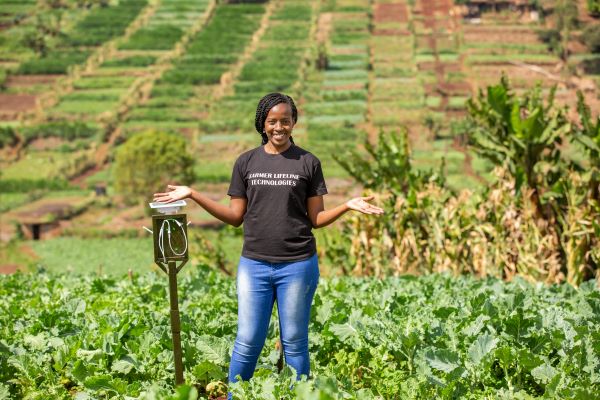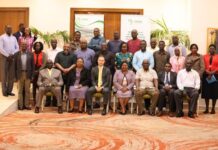If farmers can harvest and sell more produce, and earn more money, they can make a better life. In principle, it sounds straight-forward, but out in the fields, far from a physical marketplace or reliable internet, it is not the simplest process.
This is because other than lacking the proper knowledge about the state of their farm soils and how to improve them for bumper yields, pests and diseases invasion is another pain point and in the wake of climate change challenges, the enemies of farmers are increasing and resurgent.
The United Nations’ Food and Agriculture Organization (FAO) estimates that, annually, up to 40 per cent of global crop production is lost to the pests and that each year, plant diseases cost the global economy over $220 billion and invasive insects at least $70 billion.
However, technology is bringing about fresh air for farmers through innovations of new methods to combat the menace.
One such innovation is a proprietary disease detection device (Patent No:KE/UM/2023/2015) developed by Farmer Lifeline Technologies, a Kenyan agritech startup that helps farmers to get ahead of pests and pathogens by enabling timely detection of crop pests and crop diseases.
Behind this revolutionary innovation is a 26 year old Esther Wanjiru Kimani who is also a computer science expert. She hails from a farming family at Aberdare area in Kenya’s Nyandarua County.
Driven by the passion to transform marginalized smallholder farmers lives using technology, the trailblazer in the ClimaTech AgriTech space, says she was inspired by the need to find a solution to the prevalent destruction of crops by either pests, pathogens or delayed treatment of diseases prevalent in her birthplace.

“When I was growing up I saw my parents struggling to produce enough food from the small farm we had as a result of pests and diseases which could destroy up to 47 per cent of the crops,” said Esther adding that the situation is even worse for many farmers today due to climate change.
The device leverages on artificial intelligence (AI), data analytics and machine learning and has multiple small camera modules interfaced to a computer system.
It comes with a camera that is solar powered and can operate even in very rainy seasons and has a power retention capacity of 48 hours making it effectively detect crop diseases and pests over a 730 meters radius.
“The camera system is programmed to capture images of the crops in the field periodically and process the images using advanced computer vision algorithms to determine the nature of the infection or infestation, any pests or pathogens,” said Esther.
How Patent No:KE/UM/2023/2015 device works
The device which is solar powered is mounted in a farm, at the centre of it where once it is set it has the capacity to scan the farm by rotating and taking pictures frequently.
The scanning using a camera can cover a 730 meters radius with an aim to identify if there could be any pests or diseases in the farm.
The camera has a long footing usually put into the soil with the camera-ball interface overlooking the plants or farm to detect and predict crop diseases, pathogens and pests’ infections
In case a pest is recognized or disease identified, the data is sent to an analytic dashboard for analysis and results sent to the farmer through an SMS for action.
“In this,” says Esther, “farmers are able to realise early detection of crop pests and disease in a bid to maximize their yields and prevent post-harvest losses.”
The device also recommends locally sourced, carbon-negative, and health-friendly fertilizers and farm chemicals to address the identified crop pests or diseases.
Cutting-edge technology
According to the young innovator, the cutting-edge technology promotes sustainable farming practices and helps smallholder farmers adapt to climate change by encouraging behavior change.
“By suggesting the use of farm chemicals and fertilizers with minimal greenhouse gas emissions, the device empowers farmers to take a more environmentally friendly approach to agriculture,” she said.
Problems the technology seeks to solve
Among the problems that this technology seeks to address are delayed identification of crop diseases and pests’ infestation, use of wrong chemicals and pesticides due to inaccurate identification of crop disease and pests and application of wrong fertilizers due to incorrect predictions of crop diseases.
The company plans to commercialize the data generated by the devices to governments and non-governmental organizations to support in policy making. It will also sell or lease the devices to farmers and farmers groups.
So far, the innovator has acquired patents for the technology and intends to partner with the ministries of agriculture in Kenya, Tanzania, Uganda, Burundi, and Egypt by 2022.
Proven results and cost implications
Esther says that the technology has gone a series of tests and proven effective by majority of smallholder farmers within Kenya and outside the country.
“I am happy that many women who account for over 60 per cent of farmers and who have used the device have been able to reduce losses in their farms by more than 40 per cent meaning that they have improved their livelihoods and narrowed economic inequality gap between them and men.”
The company has also collaborated with a Canadian NGO to run a test among 400 farmers in the country of which 360 who used the technology recorded 40per cent production increase and 30 per cent reduction in losses.
“Our technology has so far had recommendations by governments, non-governmental organizations and AGRA among others and we are encouraged by this,” said Esther.
To reduce cost implications on the targeted small-scale farmers, Farmer Lifeline Technologies partners with manufacturers to make the devices usable anywhere in the world at a low cost saying that “we want to see farmers improve their earnings and livelihoods.”
The company leases the device to farmers or farmer groups at $1 for a period of one month with a guarantee to give cash back for any farmer who buys or leases the device and does not get 30-40 per cent farm harvest increase within the first 4 months.
Awards
The innovation has seen the company recognised, featured and won several awards that include COMESA Award, African Agrihack, TotalStartUpper, 2022 GoGettaz competition and AWIEF African among others.
“We also scooped an award under Youth Adapt at the UN Conference of Parties (COP27) Egypt 2022 thanks to GCA, AFDB, and CIF for support,” said Esther.










This is very interesting Tech and being locally developed by our own scientists is a real plus. Is it available for sale…and what’s the price range?
Hi Thomas, the device is available for hire but for more reach out to FarmerLifeline company on info@farmerlifeline.co.ke or +254 700093587
Comments are closed.